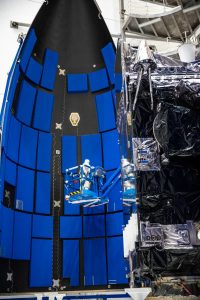
By Jim Cawley
NASA’s Kennedy Space Center
Now safely encapsulated, the National Oceanic and Atmospheric Administration’s (NOAA) Geostationary Operational Environmental Satellite-T (GOES-T) satellite has completed another key milestone in preparation for its March 1, 2022, launch from Cape Canaveral Space Force Station in Florida.

Inside the Astrotech Space Operations facility in nearby Titusville, the two halves of the United Launch Alliance Atlas V payload fairings were brought together and installed around GOES-T. The payload fairings will secure and protect the satellite during launch.
“Things are getting real now; GOES-T is fully assembled and ready for launch,” said GOES-T Mission Manager Rex Engelhardt. “Next week, we will be holding the final launch reviews and exercising the teams on their launch consoles in preparation for launch day.”
Last month, technicians began integrated operations, which included lifting and mating the spacecraft to the payload adapter – a piece of hardware that interfaces mechanically between the rocket and the spacecraft. On Feb. 17, GOES-T will be transported and mated to the launch vehicle. The fully assembled launch vehicle is targeted to roll to the launch pad on Feb. 28.
The third satellite in NOAA’s GOES-R series, GOES-T will lift off atop the Atlas V 541 rocket from Space Launch Complex 41. The launch is managed by NASA’s Launch Services Program based at the agency’s Kennedy Space Center, America’s multi-user spaceport.
The GOES satellite network helps meteorologists observe and predict local weather events that affect public safety, including thunderstorms, tornadoes, fog, hurricanes, flash floods, and other severe weather. GOES-T will provide critical data for the U.S. West Coast, Alaska, Hawaii, Mexico, Central America, and the Pacific Ocean.
Click here to follow the GOES-T blog. To learn more about the GOES Satellite Network or to meet members of the GOES-T team, click here.
